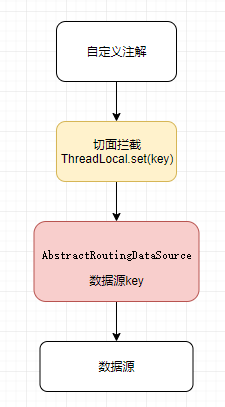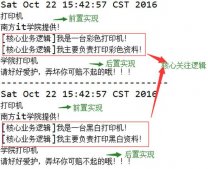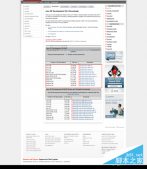spring多数据源实现的方式大概有2中,一种是新建多个mapperscan扫描不同包,另外一种则是通过继承abstractroutingdatasource实现动态路由。今天作者主要基于后者做的实现,且方式1的实现比较简单这里不做过多探讨。
实现方式
方式1的实现(核心代码):
|
1
2
3
4
5
6
7
8
9
10
11
12
13
14
15
16
17
18
19
20
21
22
23
24
25
26
27
|
@configuration@mapperscan(basepackages = "com.goofly.test1", sqlsessiontemplateref = "test1sqlsessiontemplate")public class datasource1config1 { @bean(name = "datasource1") @configurationproperties(prefix = "spring.datasource.test1") @primary public datasource testdatasource() { return datasourcebuilder.create().build(); } // .....略}@configuration@mapperscan(basepackages = "com.goofly.test2", sqlsessiontemplateref = "test1sqlsessiontemplate")public class datasourceconfig2 { @bean(name = "datasource2") @configurationproperties(prefix = "spring.datasource.test2") @primary public datasource testdatasource() { return datasourcebuilder.create().build(); } // .....略} |
方式2的实现(核心代码):
|
1
2
3
4
5
6
7
8
9
|
public class dynamicroutingdatasource extends abstractroutingdatasource { private static final logger log = logger.getlogger(dynamicroutingdatasource.class); @override protected object determinecurrentlookupkey() { //从threadlocal中取值 return dynamicdatasourcecontextholder.get(); }} |
第1种方式虽然实现比较加单,劣势就是不同数据源的mapper文件不能在同一包名,就显得不太灵活了。所以为了更加灵活的作为一个组件的存在,作者采用的第二种方式实现。
设计思路

- 当请求经过被注解修饰的类后,此时会进入到切面逻辑中。
- 切面逻辑会获取注解中设置的key值,然后将该值存入到threadlocal中
- 执行完切面逻辑后,会执行abstractroutingdatasource.determinecurrentlookupkey()方法,然后从threadlocal中获取之前设置的key值,然后将该值返回。
- 由于abstractroutingdatasource的targetdatasources是一个map,保存了数据源key和数据源的对应关系,所以能够顺利的找到该对应的数据源。
源码解读
org.springframework.jdbc.datasource.lookup.abstractroutingdatasource,如下:
|
1
2
3
4
5
6
7
8
9
10
11
12
13
14
15
16
17
18
19
20
21
22
23
24
25
26
27
28
29
30
31
32
|
public abstract class abstractroutingdatasource extends abstractdatasource implements initializingbean { private map<object, object> targetdatasources; private object defaulttargetdatasource; private boolean lenientfallback = true; private datasourcelookup datasourcelookup = new jndidatasourcelookup(); private map<object, datasource> resolveddatasources; private datasource resolveddefaultdatasource; protected datasource determinetargetdatasource() { assert.notnull(this.resolveddatasources, "datasource router not initialized"); object lookupkey = determinecurrentlookupkey(); datasource datasource = this.resolveddatasources.get(lookupkey); if (datasource == null && (this.lenientfallback || lookupkey == null)) { datasource = this.resolveddefaultdatasource; } if (datasource == null) { throw new illegalstateexception("cannot determine target datasource for lookup key [" + lookupkey + "]"); } return datasource; } /** * determine the current lookup key. this will typically be * implemented to check a thread-bound transaction context. * <p>allows for arbitrary keys. the returned key needs * to match the stored lookup key type, as resolved by the * {@link #resolvespecifiedlookupkey} method. */ protected abstract object determinecurrentlookupkey(); //........略 |
targetdatasources是一个map结构,保存了key与数据源的对应关系;
datasourcelookup是一个datasourcelookup类型,默认实现是jndidatasourcelookup。点开该类源码会发现,它实现了通过key获取datasource的逻辑。当然,这里可以通过setdatasourcelookup()来改变其属性,因为关于此处有一个坑,后面会讲到。
|
1
2
3
4
5
6
7
8
9
10
11
12
13
14
15
16
17
18
|
public class jndidatasourcelookup extends jndilocatorsupport implements datasourcelookup { public jndidatasourcelookup() { setresourceref(true); } @override public datasource getdatasource(string datasourcename) throws datasourcelookupfailureexception { try { return lookup(datasourcename, datasource.class); } catch (namingexception ex) { throw new datasourcelookupfailureexception( "failed to look up jndi datasource with name '" + datasourcename + "'", ex); } }} |
组件使用
多数据源
|
1
2
3
4
5
6
7
8
9
10
11
12
13
14
15
16
17
18
19
|
# db1spring.datasource.master.url = jdbc:mysql://127.0.0.1:3306/test?useunicode=true&characterencoding=utf8&usessl=falsespring.datasource.master.username = rootspring.datasource.master.password = 123456spring.datasource.master.driverclassname = com.mysql.jdbc.driverspring.datasource.master.validationquery = truespring.datasource.master.testonborrow = true## db2spring.datasource.slave.url = jdbc:mysql://127.0.0.1:3306/test1?useunicode=true&characterencoding=utf8&usessl=falsespring.datasource.slave.username = rootspring.datasource.slave.password = 123456spring.datasource.slave.driverclassname = com.mysql.jdbc.driverspring.datasource.slave.validationquery = truespring.datasource.slave.testonborrow = true#主数据源名称spring.maindb=master#mapperper包路径mapper.basepackages =com.btps.xli.multidb.demo.mapper |
单数据源
为了让使用者能够用最小的改动实现最好的效果,作者对单数据源的多种配置做了兼容。
示例配置1(配置数据源名称):
|
1
2
3
4
5
6
7
8
9
10
11
|
spring.datasource.master.url = jdbc:mysql://127.0.0.1:3306/test?useunicode=true&characterencoding=utf8&usessl=falsespring.datasource.master.username = rootspring.datasource.master.password = 123456spring.datasource.master.driverclassname = com.mysql.jdbc.driverspring.datasource.master.validationquery = truespring.datasource.master.testonborrow = true# mapper包路径mapper.basepackages = com.goofly.xli.multidb.demo.mapper# 主数据源名称spring.maindb=master |
示例配置2(不配置数据源名称):
|
1
2
3
4
5
6
7
8
9
|
spring.datasource.url = jdbc:mysql://127.0.0.1:3306/test?useunicode=true&characterencoding=utf8&usessl=falsespring.datasource.username = rootspring.datasource.password = 123456spring.datasource.driverclassname = com.mysql.jdbc.driverspring.datasource.validationquery = truespring.datasource.testonborrow = true# mapper包路径mapper.basepackages = com.goofly.xli.multidb.demo.mapper |
踩坑之路
多数据源的循环依赖
|
1
2
3
4
5
6
7
8
9
10
11
12
13
14
15
16
17
|
description:the dependencies of some of the beans in the application context form a cycle: happinesscontroller (field private com.db.service.happinessservice com.db.controller.happinesscontroller.happinessservice) ↓ happinessserviceimpl (field private com.db.mapper.masterdao com.db.service.happinessserviceimpl.masterdao) ↓ masterdao defined in file [e:\gitrepository\framework-gray\test-db\target\classes\com\db\mapper\masterdao.class] ↓ sqlsessionfactory defined in class path resource [com/goofly/xli/datasource/core/dynamicdatasourceconfiguration.class]┌─────┐| dynamicdatasource defined in class path resource [com/goofly/xli/datasource/core/dynamicdatasourceconfiguration.class]↑ ↓| firstdatasource defined in class path resource [com/goofly/xli/datasource/core/dynamicdatasourceconfiguration.class]↑ ↓| datasourceinitializer |
解决方案:
在spring boot启动的时候排除datasourceautoconfiguration即可。如下:
|
1
2
3
4
5
6
|
public class dbmain { public static void main(string[] args) { springapplication.run(dbmain.class, args); }} |
但是作者在创建多数据源的时候由于并未创建多个datasource的bean,而是只创建了一个即需要做动态数据源的那个bean。 其他的datasource则直接创建实例然后存放在map里面,然后再设置到dynamicroutingdatasource#settargetdatasources即可。
因此这种方式也不会出现循环依赖的问题!
动态刷新数据源
笔者在设计之初是想构建一个动态刷新数据源的方案,所以利用了springcloud的@refreshscope去标注数据源,然后利用refreshscope#refresh实现刷新。但是在实验的时候发现由druid创建的数据源会因此而关闭,由spring的datasourcebuilder创建的数据源则不会发生任何变化。
最后关于此也没能找到解决方案。同时思考,如果只能的可以实现动态刷新的话,那么数据源的原有连接会因为刷新而中断吗还是会有其他处理?
多数据源事务
有这么一种特殊情况,一个事务中调用了两个不同数据源,这个时候动态切换数据源会因此而失效。
翻阅了很多文章,大概找了2中解决方案,一种是atomikos进行事务管理,但是貌似性能并不是很理想。
另外一种则是通过优先级控制,切面的的优先级必须要大于数据源的优先级,用注解@order控制。
此处留一个坑!
以上就是本文的全部内容,希望对大家的学习有所帮助,也希望大家多多支持服务器之家。
原文链接:https://segmentfault.com/a/1190000017989247














